Embark on a creative journey with our curated guide to gravel drive ideas, where aesthetics meet practicality. Discover innovative designs, material options, and expert tips to transform your driveway into a stunning focal point that complements your home’s style and enhances your daily routine.
From elegant patterns to functional edging solutions, our comprehensive exploration provides all the inspiration and knowledge you need to create a gravel driveway that not only adds curb appeal but also ensures durability and ease of maintenance.
Design Ideas for Gravel Driveways
Gravel driveways offer a versatile and durable option for enhancing the curb appeal of your property. Here are some creative design concepts to inspire you:
Incorporate geometric patterns to create a visually striking driveway. Arrange the gravel in alternating rows of different colors or sizes to form stripes, checkers, or herringbone designs. Consider using contrasting materials, such as crushed stone and pea gravel, to add depth and texture.
Unique Layouts
Break away from the traditional straight driveway and explore curved or serpentine layouts. These designs can create a sense of movement and visual interest, especially when combined with strategically placed landscaping elements. Consider creating a circular driveway with a central focal point, such as a fountain or statue.
Material Selection for Gravel Driveways
Gravel driveways offer a blend of durability, affordability, and aesthetic appeal. Choosing the right gravel material is crucial for ensuring the driveway’s longevity, functionality, and appearance.When selecting gravel for driveways, consider the following factors: durability, drainage, aesthetics, cost, and availability.
Durable gravel resists wear and tear from vehicles and weather elements. Proper drainage prevents waterlogging and damage to the driveway’s base. Aesthetics play a role in enhancing the property’s curb appeal. Cost and availability are practical considerations that influence the choice.
Types of Gravel
Various types of gravel are suitable for driveways, each with unique properties:
-
-*Crushed Stone
Angular and durable, providing excellent traction and drainage.
-*Pea Gravel
Smooth and round, creating a more decorative and comfortable surface.
-*Recycled Concrete
Environmentally friendly and cost-effective, offering good drainage and durability.
-*Limestone
Durable and visually appealing, but can be more expensive.
-*Granite
Highly durable and resistant to fading, but can be more expensive.
Edging Options for Gravel Driveways
Gravel driveways require proper edging to prevent the gravel from spreading and to enhance the overall aesthetics of the driveway. Edging materials come in various options, each with its unique advantages and disadvantages.
Concrete Edging
Concrete edging is a durable and long-lasting option that provides a clean and defined edge to the driveway. It can be poured in place or precast into blocks. Concrete edging is relatively expensive to install but offers excellent stability and resistance to movement.
Brick Edging
Brick edging adds a classic and elegant touch to gravel driveways. Bricks can be laid in various patterns, creating a decorative border. Brick edging is durable and can withstand heavy traffic, but it requires regular maintenance to prevent cracking or crumbling.
Metal Edging
Metal edging is a versatile option available in different materials such as aluminum, steel, or galvanized steel. It is easy to install and can be curved or bent to follow the contours of the driveway. Metal edging is durable and rust-resistant, but it can be more expensive than other options.
Plastic Edging
Plastic edging is a budget-friendly option that is easy to install and flexible. It is available in various colors and styles, allowing for customization. However, plastic edging is less durable than other materials and may require frequent replacement.
Choosing the Best Edging, Gravel drive ideas
The best edging option for a gravel driveway depends on factors such as budget, durability, aesthetics, and the specific design of the driveway. Consider the following tips:
- For a formal and sophisticated look, concrete or brick edging is recommended.
- For a durable and low-maintenance option, metal edging is a suitable choice.
- For a budget-friendly and customizable option, plastic edging is a viable alternative.
- For driveways with curves or irregular shapes, metal or plastic edging offers flexibility in design.
Installation Techniques for Gravel Driveways
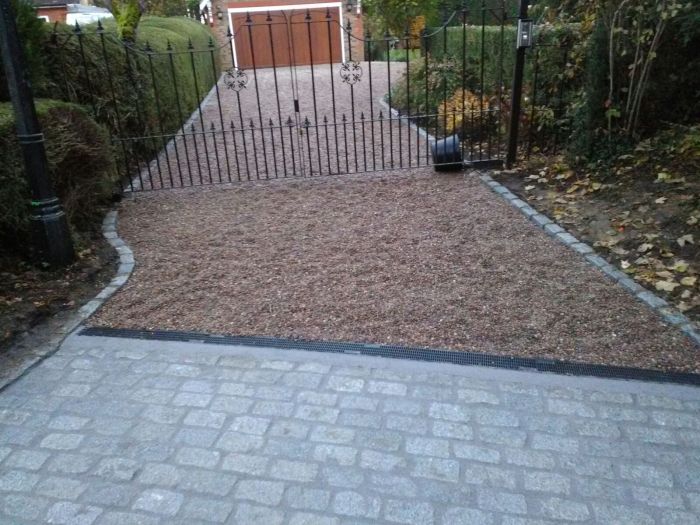
Installing a gravel driveway is a cost-effective and versatile option for homeowners. Proper preparation and installation techniques are crucial to ensure durability and functionality.
Step-by-Step Installation
- Prepare the Base:Clear the area of vegetation, level the ground, and create a stable base using crushed stone or compacted soil.
- Install Edging:Define the driveway’s boundaries using edging materials like concrete, pavers, or treated lumber to prevent gravel migration.
- Spread Gravel:Choose the appropriate gravel size and depth for your specific needs. Spread it evenly over the prepared base, compacting it as you go.
- Compact the Gravel:Use a plate compactor or heavy roller to firmly pack the gravel, ensuring it’s stable and can withstand traffic.
- Add Finishing Touches:Apply a layer of pea gravel or decomposed granite on top for a smooth and polished look.
Importance of Proper Preparation and Compaction
Thorough preparation and compaction are essential for a durable driveway. A stable base prevents the gravel from sinking or shifting, while proper compaction ensures the surface can handle the weight of vehicles without rutting or erosion.
Common Installation Mistakes to Avoid
- Inadequate Base Preparation:Neglecting to prepare a stable base can lead to sinking and instability.
- Lack of Edging:Failing to install edging allows gravel to spread and create uneven surfaces.
- Insufficient Compaction:Poor compaction results in a loose and unstable driveway, prone to rutting and erosion.
- Wrong Gravel Size:Using gravel that’s too small or too large can compromise durability and stability.
Maintenance Tips for Gravel Driveways
Maintaining a gravel driveway is crucial for its longevity and aesthetic appeal. Here are some regular maintenance tips to keep your gravel driveway in top condition:
Weed Control
Weeds can quickly take over a gravel driveway, detracting from its appearance and potentially damaging the gravel base. Regular weed control is essential. Apply a herbicide specifically designed for gravel driveways, following the manufacturer’s instructions. You can also manually remove weeds by hand-pulling or using a hoe.
Erosion Control
Erosion can wash away gravel and create unsightly ruts. Prevent erosion by installing a geotextile fabric under the gravel. This fabric allows water to drain while preventing soil and gravel from being displaced. Additionally, create a slight slope on the driveway to encourage water runoff.
Pothole Repair
Potholes can develop in gravel driveways due to heavy traffic or water damage. To repair potholes, fill them with fresh gravel and compact it firmly. If the pothole is large or deep, you may need to excavate the area and replace the base material before filling it with gravel.
Seasonal Maintenance
Gravel driveways require seasonal maintenance to withstand different weather conditions:
Spring
Remove any accumulated debris, such as leaves and sticks. Inspect the driveway for any damage and make necessary repairs.
Summer
Keep the driveway free of weeds and debris. Apply a dust suppressant to reduce dust and maintain a smooth surface.
Fall
Remove fallen leaves and debris promptly to prevent them from compacting and becoming difficult to remove.
Winter
Plow or shovel snow promptly to prevent ice buildup. Avoid using salt or ice melt on gravel driveways, as it can damage the gravel.
Gravel Driveway Costs
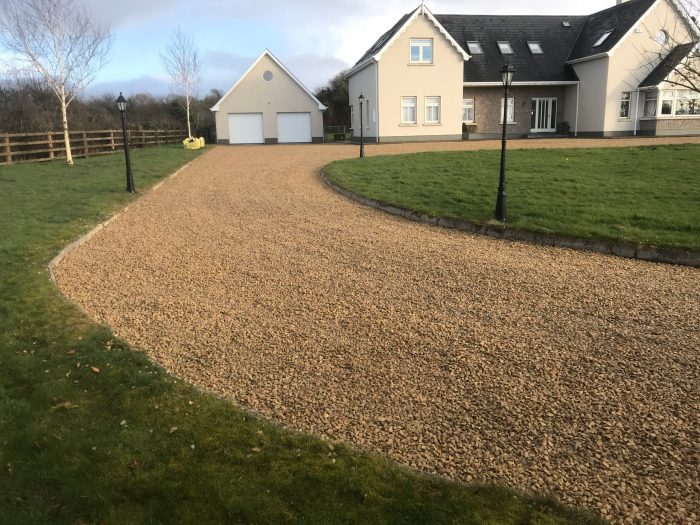
Gravel driveways offer an affordable and durable option for homeowners, but the cost can vary depending on several factors. Understanding these factors and estimating the cost of a gravel driveway can help you plan your project effectively.Variables that influence the cost of a gravel driveway include:
Material
The type of gravel used, such as crushed stone, pea gravel, or river rock, affects the cost.
Size
The size of the driveway, measured in square footage, determines the amount of gravel needed.
Installation
The method of installation, whether self-installed or professionally done, impacts the cost.To estimate the cost of a gravel driveway, follow these tips:
- Determine the size of your driveway by measuring its length and width.
- Research the cost of different gravel materials in your area.
- Get quotes from contractors if you plan to hire a professional for installation.
- Consider the cost of additional materials, such as edging and weed barrier.
- Factor in the cost of maintenance, such as occasional re-grading and adding gravel as needed.
Gravel Driveway Design with Landscaping
Combining gravel driveways with landscaping can elevate their aesthetic appeal and enhance the overall property’s charm. By integrating plants, shrubs, and trees, you can create a cohesive outdoor space that seamlessly blends function with beauty.
When selecting plant materials for gravel driveways, consider their compatibility with the unique conditions of the area. Plants should be able to tolerate the compacted soil and limited moisture availability. Some suitable options include creeping thyme, sedum, and drought-tolerant grasses.
Plant Placement and Design
- Edging Plants:Low-growing plants like creeping thyme or sedum can be planted along the edges of the driveway to create a defined border and prevent gravel from spilling over.
- Groundcovers:Creeping plants like ivy or vinca can be used to cover larger areas, suppressing weeds and adding a touch of greenery to the driveway.
- Specimen Trees:A single, well-placed tree can serve as a focal point and provide shade for the driveway. Choose trees with strong root systems that can withstand the weight of vehicles.
- Shrub Clusters:Clusters of shrubs can be planted along the sides of the driveway to add height and texture. Select shrubs that are compact and can tolerate the conditions.
Gravel Driveway Drainage Solutions
Ensuring proper drainage is crucial for gravel driveways to prevent water damage and erosion. Implementing effective drainage techniques helps direct water away from the driveway surface, preserving its integrity and longevity.
Grading
Proper grading involves shaping the driveway’s surface to create a slight slope that allows water to drain away from the house and surrounding areas. The slope should be gradual, typically around 1-2%, to prevent water from pooling or eroding the gravel.
Culverts
Culverts are underground pipes that allow water to pass beneath the driveway. They are installed in areas where water tends to accumulate or cross the driveway’s path. Culverts help prevent water from saturating the gravel and causing damage.
Dry Wells
Dry wells are deep holes filled with gravel or perforated pipe that collect and disperse excess water. They are ideal for areas with poor soil drainage or where the water table is high. Dry wells allow water to percolate into the ground, reducing the risk of flooding or erosion.
Gravel Driveway Lighting Ideas
Enhance the safety, functionality, and aesthetic appeal of your gravel driveway with well-planned lighting. Explore various lighting options tailored to illuminate paths, accentuate features, and ensure security.
Path Lighting
Guide visitors and ensure safe passage with path lighting. Choose fixtures that emit a soft glow, such as bollards or recessed lights, to illuminate the path without creating glare.
Accent Lighting
Highlight architectural elements, landscaping, or water features with accent lighting. Spotlights or floodlights can be strategically placed to draw attention to specific areas and create a dramatic effect.
Security Lighting
Deter unwanted guests and provide peace of mind with security lighting. Motion-activated floodlights or solar-powered path lights can illuminate dark corners and provide a sense of security.
Gravel Driveway DIY Projects: Gravel Drive Ideas
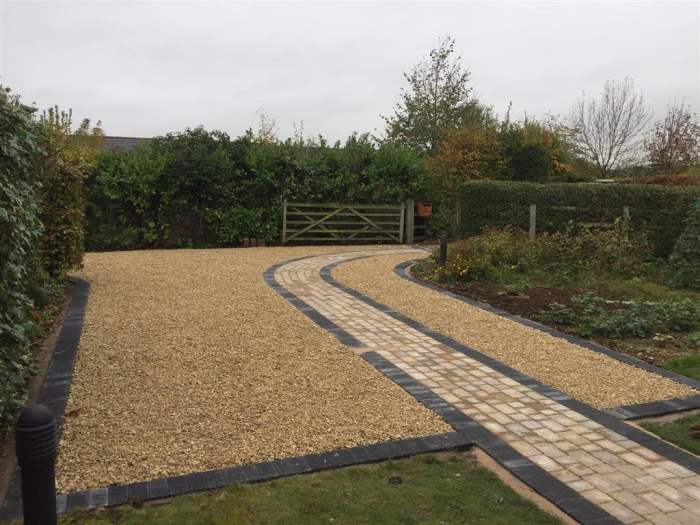
DIY projects for gravel driveways can save you money and give you a sense of accomplishment. Here are a few small-scale projects that you can tackle yourself:
Edging
Gravel driveways can benefit from edging to keep the gravel in place and prevent it from spreading onto your lawn or other areas. You can use a variety of materials for edging, such as:
- Concrete pavers
- Bricks
- Plastic edging
- Metal edging
To install edging, simply dig a trench around the perimeter of your driveway and insert the edging material. Backfill the trench with soil and tamp it down to secure the edging.
Repairs
If your gravel driveway develops potholes or other damage, you can repair it yourself using the following steps:
- Remove any loose gravel from the damaged area.
- Fill the damaged area with new gravel.
- Compact the new gravel using a hand tamper or a plate compactor.
- Smooth the surface of the gravel with a rake.
Maintenance
To keep your gravel driveway in good condition, it is important to perform regular maintenance, such as:
- Removing weeds and debris
- Filling in potholes
- Compacting the gravel
- Grading the gravel
By following these simple tips, you can keep your gravel driveway looking its best for years to come.
Gravel Driveway Inspiration Gallery
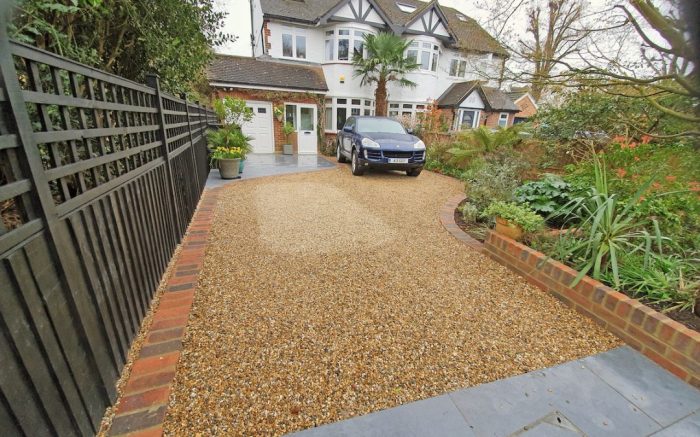
Prepare to be inspired by a captivating gallery showcasing a diverse range of gravel driveway designs. Explore a spectrum of styles, materials, and landscaping concepts, each offering a unique aesthetic and functional solution. Immerse yourself in the visual splendor and discover the perfect inspiration for your own driveway transformation.
Our gallery features high-resolution images that capture the intricate details and stunning beauty of these gravel driveways. Each image is accompanied by a brief description and design details, providing you with valuable insights into the planning and execution of these inspiring projects.
Contemporary Elegance
- A sleek and modern gravel driveway, complemented by crisp lines and geometric shapes in the surrounding landscape. The gray gravel complements the cool tones of the contemporary home, creating a cohesive and inviting exterior.
- A winding gravel driveway meanders through a lush garden, creating a sense of tranquility and seclusion. The natural tones of the gravel blend seamlessly with the surrounding greenery, enhancing the overall aesthetic appeal.
- A wide and expansive gravel driveway provides ample parking space while maintaining a rustic charm. The warm tones of the gravel add warmth and character to the traditional-style home, creating a welcoming and inviting ambiance.
Closure
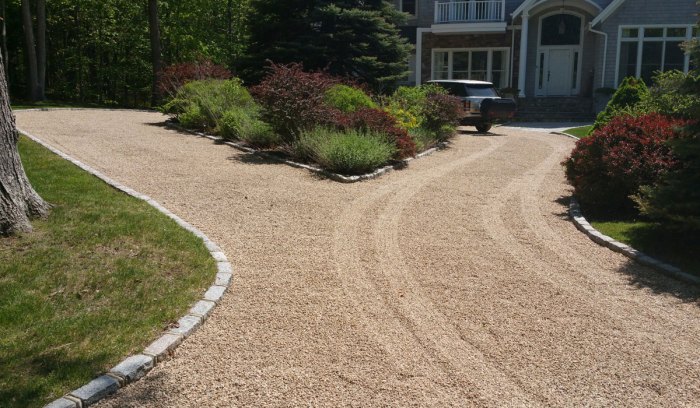
Whether you’re seeking a classic, rustic, or modern aesthetic, our gravel drive ideas empower you to design a driveway that reflects your unique taste and practical needs. Embrace the versatility of gravel and elevate your home’s exterior with a driveway that combines beauty and functionality.
Question Bank
How do I choose the right gravel material for my driveway?
Consider factors such as durability, drainage, and aesthetic appeal. Crushed stone is a popular choice for its strength and affordability, while pea gravel offers a smoother surface and better drainage.
What are the advantages of using gravel for my driveway?
Gravel driveways are cost-effective, low-maintenance, and permeable, allowing rainwater to drain naturally. They also provide good traction and can withstand heavy traffic.
How can I prevent weeds from growing in my gravel driveway?
Use a weed barrier fabric beneath the gravel to suppress weed growth. Regular maintenance, such as sweeping or raking, can also help prevent weeds from taking root.


